FV101 Scorpion
The FV101 Scorpion is a British armoured reconnaissance vehicle, and also a light tank. It was the lead vehicle and the fire support type in the Combat Vehicle Reconnaissance (Tracked), CVR(T), family of seven armoured vehicles. Manufactured by Alvis, it was introduced into service with the British Army in 1973 and was withdrawn in 1994.[4][5] More than 3,000 were produced and used as a reconnaissance vehicle or a light tank.
| FV101 Scorpion | |
|---|---|
.jpg.webp) Irish Army Scorpion CVR(T) | |
| Type | Reconnaissance vehicle, light tank |
| Place of origin | United Kingdom |
| Service history | |
| In service | 1973–present |
| Used by | Operators |
| Wars | Iran–Iraq War[1] Falklands war 1989 Philippine coup d'état attempt Gulf war Zamboanga City crisis |
| Production history | |
| Manufacturer | Alvis Vehicles, Coventry, England |
| No. built | c. 3,000 (1,500 for UK, c. 1,500 exported)[2] |
| Variants | Scorpion 90 |
| Specifications | |
| Mass | 17,800 lb (8.074 tonnes) |
| Length | 5.288 m (17 ft 4.2 in)[3] |
| Width | 2.134 m (7 ft 0 in)[3] |
| Height | 2.102 m (6 ft 10.8 in)[3] |
| Crew | 3[3] |
| Armour | Aluminium armour, Cast and 1318b plate |
Main armament | ROF 76mm L23A1 gun 90mm Cockerill Mk3 M-A1 gun (in Scorpion 90)[3] |
Secondary armament | Coaxial 7.62 mm L43A1 machine gun[3] |
| Engine | Cummins BTA 5.9-litre (diesel)[3] 190 hp (140 kW) |
| Power/weight | 22.92 hp (17.3 kW) / tonne[3] |
| Transmission | Self Change Gears TN15X[3] |
| Suspension | Torsion-bar |
Operational range | 756 km (470 mi)[3] |
| Maximum speed | 72.5 km/h (45.0 mph)[3] |
It holds the Guinness world record for the fastest production tank, recorded doing 82.23 km/h (51.10 mph) at the QinetiQ vehicle test track in Chertsey, Surrey, on 26 January 2002.[6]
History
The Combat Vehicle Reconnaissance (Tracked) family of vehicles came from a British Army requirement for an armoured fighting vehicle that could be rapidly airlifted to trouble spots. The 'Armoured Vehicle Reconnaissance' was supposed to carry both a gun and an anti-tank missile but it was not possible to design an air portable vehicle to the specification. The limits on both size and weight led to the use of aluminium alloy for the hull and an adapted car engine for power. The anti-tank capability was given to a dedicated vehicle- Striker while what became Scorpion would use a 76 mm gun for "fire support".
In 1967, Alvis was awarded the contract to produce 30 CVR(T) prototypes. Vehicles P1–P17, the Scorpion prototypes, were delivered on time and within the budget.[7] After extensive hot and cold weather trials in Norway, Australia, Abu Dhabi and Canada, the Scorpion was accepted by the British Army in May 1970, with a contract for 275, which later rose to 313 vehicles.[8] The first production vehicles were completed in 1972 and the first British regiment to be equipped with the Scorpion was the Blues and Royals of the Household Cavalry in 1973.[8][9]
Alvis built more than 3,000 Scorpion vehicles for the British Army, Royal Air Force Regiment and the export market. All of the CVR(T) vehicles were to be air-portable; and two Scorpions could be carried in a Lockheed C-130 Hercules. Another requirement of the CVR(T) project was the low ground pressure, similar to that of a soldier on foot; this would serve it well in the boggy conditions of the Falklands War.
Armament
| L23A1 gun | |
|---|---|
| Place of origin | United Kingdom |
| Service history | |
| In service | 1973–present |
| Production history | |
| Manufacturer | Royal Ordnance |
| Specifications | |
| Length | 2.157 m (7 ft 0.9 in) |
| Calibre | 76 mm (3.0 in) |
| Elevation | +35 degrees/-10 degrees |
| Rate of fire | 6 rounds per minute |
| Effective firing range | 2,200 m (2,400 yd) |
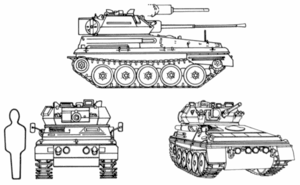
The Scorpion was armed with the low velocity 76 mm L23A1 gun, which could fire high-explosive, HESH, smoke and canister rounds. Storage was provided for 40 or 42 rounds. A 7.62 mm coaxial L7 GPMG (3,000 rounds carried) was also fitted, as were two multi-barrelled smoke grenade dischargers, one on each side of the turret.[3] The main armament has an elevation of 35 degrees and a depression of 10 degrees; the turret has a full 360-degree traverse.[10] The traverse was however hand-cranked, a cost-saving feature that made the turret relatively slow and laborious to traverse relative to other vehicles of its type.[11] This gun was later deemed to be unsatisfactory, as RAF testing showed that the lack of a fume extraction system caused toxic fumes to enter the fighting compartment, endangering the crew's health.[11]
Engine
The original engine was the Jaguar J60 Mk 100b 4.2-litre petrol engine,[12] which was replaced by a Cummins or Perkins diesel engine.[3] The maximum speed was about 50 mph (80 km/h) and it could accelerate from standing to 30 mph (48 km/h) in 16 seconds. The maximum speed on water (with the flotation screen deployed) was 3.6 mph (5.8 km/h).[13] The Irish engineering company IED replaced the Jaguar engine in Irish Army Scorpions with a Steyr M16 TCA HD engine (6-cylinder, 145 kW), making the Scorpion more powerful and more reliable in critical environments.[14]
Armour
The FV101 was a very light armoured vehicle, weighing in at a mere 8 tonnes. This meant some compromises had to be made on protection. The vehicle had 12.7 mm[15] of sloped aluminium armour,[16][17] giving an average effective thickness of 25 mm.[18]
The FV101 had all-around protection from shell fragments and 7.62 mm rounds,[19] and the heavily sloped frontal arc was designed to be resistant to 14.5 mm rounds fired from 200 m (660 ft).[20][21] The initial manufacture of the aluminium armour resulted, after time and effects of the environment, in failure; "Stress Corrosion Cracking" (SCC) which seriously affected all early builds.
Other systems
The vehicle was fitted with a nuclear, biological, chemical protection system, image intensification sights for gunner and driver and a floatation screen.[3] A commode was located under the commander's seat. An internal water tank and a boiling vessel for cooking and heating water were also provided.[22]
Service history
The Scorpion was or is used by the armed forces of Belgium, Botswana, Brunei, Chile, Honduras, Iran, Indonesia, Ireland, Jordan, Malaysia, New Zealand, Nigeria, Oman, Philippines, Spain, Tanzania, Thailand, Togo, the United Arab Emirates, and Venezuela.[3] The Iranian army acquired 250 Scorpions in the late 1970s and a number of them are still in use after being refurbished locally as the Tosan tank. The Scorpion was on occasion deployed to main UK airports as a measure against possible terrorist threats, e.g., Operation Marmion at Heathrow Airport in 1974.[23] Similar operations in 2003 used the then-current Scimitar.
Combat use
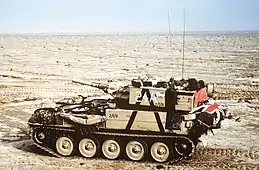
B Squadron, Blues and Royals were airlifted and deployed into the Akrotiri and Dhekelia Sovereign Base areas, during the Turkish invasion of Cyprus 1974.
Two troops from B Squadron, Blues and Royals served in the Falklands War. One troop was equipped with four Scorpions, the other with four FV107 Scimitars. These were the only armoured vehicles used in action by the British Army during the conflict.[24] Scorpions also served in the Gulf War. The 16th/5th The Queen's Royal Lancers deployed in the first Gulf War (Operation Granby) using all variants of the CVR(T) range carrying out the role of force reconnaissance for the British spearhead towards Iraq, operating forward of other official green army units. The 1st The Queen's Dragoon Guards, a reconnaissance regiment, had 32 and the close reconnaissance troops of the armoured regiments each had eight.[25] They were also used by No. 1 Squadron RAF Regiment, which was attached to the British 1st Armoured Division.
Foreign users
Some small armies, such as the Botswana Defence Force, and some larger armies such as the Iranian Army and Nigerian Army, continue to use the Scorpion, in some cases up-armed with the 90 mm Cockerill.
The Iranian army used its Scorpion tanks in the Iran–Iraq War, with various degrees of success. Early in the war, Iranians used the Scorpions's "accurate fire" (alongside the Cobra attack helicopters) to hold back Iraqi 2nd Infantry Division's offensive towards the city of Ilam.[1] However, the Scorpions proved less effective when faced with Iraq's 9th Armoured Division:[1]
A second [Iraqi] column rushed to Susangerd, which it crossed without encountering any resistance, the city having apparently been left defenseless. The column continued in the direction of Hamidiyeh. It came into contact with the [Iranian] 92nd Armored Division's reconnaissance regiment, which met it with effective in-depth defense. Yet the Iranians eventually had to yield in the face of Iraqi pressure. Their Scorpions' 90 mm guns did not hold their weight against the T-62 tanks' 115 mm guns. The Iraqis thus took control of Hamidiyeh, then Bozorg.
The British government provided Iran (and Iraq) with limited parts for their Scorpions during the war:[1]
Regarding military matters, the British government imposed two strict rules: contracts signed before the war would be honored, but the sale of equipment likely to significantly increase either side's military capacities was banned. Interpreting these regulations loosely, the British government delivered both the Iranians and the Iraqis motors and spare parts for Chieftain and Scorpion tanks, which would allow the former to maintain tanks acquired under the Shah and the latter to repair tanks captured from the Iranian army.
Variants

- Scorpion 90: The Scorpion 90 or Scorpion 2 was a version armed with the long-barrelled Cockerill Mk3 M-A1 90mm gun designed for the export market.[26]
- AVGP Cougar: The Scorpion turret was mated with the MOWAG Piranha I chassis to create the AVGP Cougar fire support vehicle, which was used by the Canadian Armed Forces.
- Sabre: The Scorpion has been withdrawn from British Army service and the refurbished hulls have been mated with surplus turrets from the FV 721 Fox CVR(W) wheeled reconnaissance vehicle to form a composite vehicle—the Sabre reconnaissance vehicle.[27]
- Salamander: A small number of converted Scorpions are in use at British Army Training Unit Suffield in Canada as part of OPFOR. With the main armament barrel replaced with a dummy they represent 125mm gun armed T-80-type vehicles.
Turret only
During the late 1960s, as a result of its experiences in the Vietnam War, the Australian Army perceived a need for a hybrid, tracked fire support and reconnaissance vehicle.
Experiments in which existing M113 APCs were fitted with Saladin (not Scorpion) turrets, wielding a 76 mm M1 gun, were successful. The vehicle entered service as the M113A1 FSV (Fire Support Vehicle).
A very similar, subsequent vehicle, attaching the turret from the Scorpion to the M113, was also known as the FSV. (This re-purposing of the turret was to be the only use of any part of the Scorpion by the ADF.) Entering service in 1976, it was later redesignated the M113A1 Medium Reconnaissance Vehicle (MRV). Its development also obviated interest in acquiring brand new, purpose-built vehicles (such as a variant of the UK CVR(T) or the M2/M3 Bradley). All of these vehicles were retired in 1996.[28]
Operators
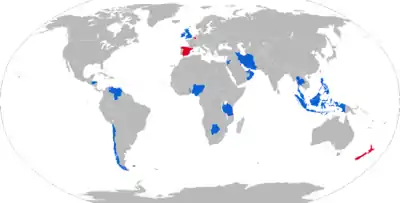
Current operators

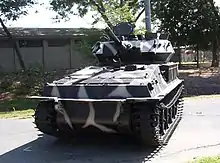
 Botswana: 25 units.[29] Purchased second-hand from Belgium and retrofitted with diesel engines as requested by Botswana.[30]
Botswana: 25 units.[29] Purchased second-hand from Belgium and retrofitted with diesel engines as requested by Botswana.[30]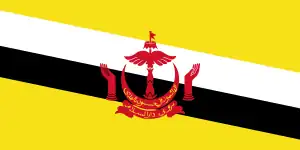 Brunei: 16 units
Brunei: 16 units Chile: 27 units; currently 15 in service in the Chilean Marine Corps. Ex-British vehicles which have been re-engined with diesel motors.
Chile: 27 units; currently 15 in service in the Chilean Marine Corps. Ex-British vehicles which have been re-engined with diesel motors.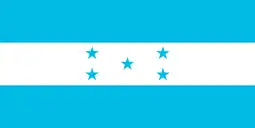 Honduras: 19 units
Honduras: 19 units Iran: Iran contracted Alvis for the supply of 250 vehicles in 1978, expanded with an additional order for 110 Scorpions shortly thereafter. Participated in the Iran-Iraq War. By 1997, the Iranian army had approx. 80 vehicles in working order.[30]
Iran: Iran contracted Alvis for the supply of 250 vehicles in 1978, expanded with an additional order for 110 Scorpions shortly thereafter. Participated in the Iran-Iraq War. By 1997, the Iranian army had approx. 80 vehicles in working order.[30] Indonesia: 90 units
Indonesia: 90 units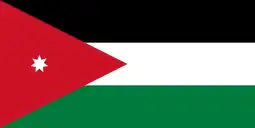 Jordan: 26 units. Likely sourced from Iraq.
Jordan: 26 units. Likely sourced from Iraq.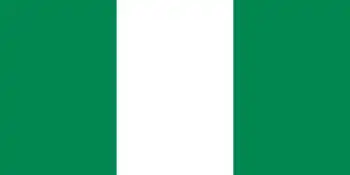 Nigeria: 150 units. In 1983, 33 vehicles were selected to be upgraded with an improved 90 mm Cockerill Mk III gun replacing the original 76 mm cannon. These vehicles were also equipped with a Belgian-sourced OIP-5 fire control system.[30]
Nigeria: 150 units. In 1983, 33 vehicles were selected to be upgraded with an improved 90 mm Cockerill Mk III gun replacing the original 76 mm cannon. These vehicles were also equipped with a Belgian-sourced OIP-5 fire control system.[30] Oman: 120 Units. Scorpion light tanks replaced the Saladin armoured car. Deliveries were carried out in several stages and included Sultan, Spartan and Samson vehicles as well as a command vehicle built on the Stormer chassis, and which were to be used in units alongside Oman's Chieftain main battle tank. The Omani vehicles are equipped with external mounting points for fuel cans and special mud flaps designed to suppress the amount of dust kicked up during travel. The NBC filtration system and heaters were removed and replaced with an air conditioning system and the vehicles received a warning siren indicating engine overheating. The hull floor was also reinforced with a 20 mm plate for increased mine resistance.[30]
Oman: 120 Units. Scorpion light tanks replaced the Saladin armoured car. Deliveries were carried out in several stages and included Sultan, Spartan and Samson vehicles as well as a command vehicle built on the Stormer chassis, and which were to be used in units alongside Oman's Chieftain main battle tank. The Omani vehicles are equipped with external mounting points for fuel cans and special mud flaps designed to suppress the amount of dust kicked up during travel. The NBC filtration system and heaters were removed and replaced with an air conditioning system and the vehicles received a warning siren indicating engine overheating. The hull floor was also reinforced with a 20 mm plate for increased mine resistance.[30] Philippines: Philippine Army: Original delivery of 41 units; seven units currently active,[31] to be replaced by the Sabrah Light Tank.[32][33]
Philippines: Philippine Army: Original delivery of 41 units; seven units currently active,[31] to be replaced by the Sabrah Light Tank.[32][33] Thailand: 100 units[34]
Thailand: 100 units[34]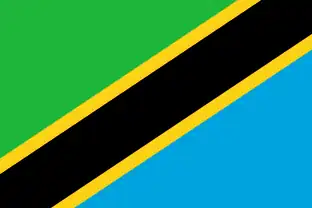 Tanzania: 40 units
Tanzania: 40 units Togo: 12 units. Includes one FV106 Samson, one FV104 Samaritan and one FV105 Sultan.
Togo: 12 units. Includes one FV106 Samson, one FV104 Samaritan and one FV105 Sultan. United Arab Emirates: 76 units, several of which were upgraded with the Pilkington Optronics TLS (Tank Laser Sight) from the Chieftain tank.
United Arab Emirates: 76 units, several of which were upgraded with the Pilkington Optronics TLS (Tank Laser Sight) from the Chieftain tank.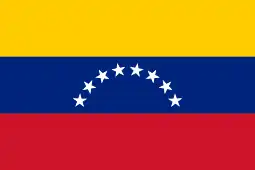 Venezuela: 78 Scorpion 90s, four to six FV104 Samaritans, two FV105 Sultans and four FV106 Samsons.[3] The vehicles were ordered in 1988 with a contract value of US$85 MM with a stipulation for diesel engines; delivery was realized in 1992.
Venezuela: 78 Scorpion 90s, four to six FV104 Samaritans, two FV105 Sultans and four FV106 Samsons.[3] The vehicles were ordered in 1988 with a contract value of US$85 MM with a stipulation for diesel engines; delivery was realized in 1992.
Former operators
.svg.png.webp) Belgium: 701 units (this total consists of all seven variants of the CVR(T)). Ordered in 1971 based on studies that showed the light tank was most suitable for the nation's topography; Belgium was the second nation to adopt the Scorpion following the British Army. First deliveries commenced in February 1973 with the vehicles assembled in Mechelen from knock-down kits supplied from the United Kingdom. The order was filled in 1980. Between 1981 and 1983, both Scorpion and Scimitar models were upgraded with mounting points for add-on armour modules, an on-board armour repair kit and other minor improvements to enhance crew comfort and ergonomics. Thirty-six Scorpions were later sold to Botswana in 1994.[30]
Belgium: 701 units (this total consists of all seven variants of the CVR(T)). Ordered in 1971 based on studies that showed the light tank was most suitable for the nation's topography; Belgium was the second nation to adopt the Scorpion following the British Army. First deliveries commenced in February 1973 with the vehicles assembled in Mechelen from knock-down kits supplied from the United Kingdom. The order was filled in 1980. Between 1981 and 1983, both Scorpion and Scimitar models were upgraded with mounting points for add-on armour modules, an on-board armour repair kit and other minor improvements to enhance crew comfort and ergonomics. Thirty-six Scorpions were later sold to Botswana in 1994.[30].svg.png.webp) Iraq: Limited number captured from Iran during Iran–Iraq War[35]
Iraq: Limited number captured from Iran during Iran–Iraq War[35] Ireland: 14 units.[36]
Ireland: 14 units.[36] Kuwait
Kuwait Malaysia: Purchased 26 units of the Scorpion 90 in 1981 equipped with smoke grenade launchers from Wegmann, in addition to 25 Stormers (12 of which were supplied with a Helio FVT900 turret armed with a 20 mm cannon and 7.62 mm coaxial machine gun and 13 vehicles received a Thyssen-Henschel TH-1 turret armed with twin 7.62 mm machine guns).[37][30]
Malaysia: Purchased 26 units of the Scorpion 90 in 1981 equipped with smoke grenade launchers from Wegmann, in addition to 25 Stormers (12 of which were supplied with a Helio FVT900 turret armed with a 20 mm cannon and 7.62 mm coaxial machine gun and 13 vehicles received a Thyssen-Henschel TH-1 turret armed with twin 7.62 mm machine guns).[37][30] New Zealand: 26 units. Ordered between 1982 and 1983; the vehicles lack NBC protection, night vision sights and do not have provisions for erecting flotation screens. The engines were upgraded with electronic fuel injection and US-made radios. In the second half of the 1980s, New Zealand opted to use the turrets to upgrade their M113 armoured personnel carriers.[30] Served with Queen Alexandra's Mounted Rifles among other units.
New Zealand: 26 units. Ordered between 1982 and 1983; the vehicles lack NBC protection, night vision sights and do not have provisions for erecting flotation screens. The engines were upgraded with electronic fuel injection and US-made radios. In the second half of the 1980s, New Zealand opted to use the turrets to upgrade their M113 armoured personnel carriers.[30] Served with Queen Alexandra's Mounted Rifles among other units. Spain: 17 units in service until 2009 with the Spanish Navy, (Infantería de Marina Española). Sold to Chile. There are a couple of units on static display as of 2011.
Spain: 17 units in service until 2009 with the Spanish Navy, (Infantería de Marina Española). Sold to Chile. There are a couple of units on static display as of 2011. United Kingdom: 1,500 units ordered. Withdrawn from active service in 1994. Served with Nos 1, 2, 15, 34, 51, 58 Squadrons Royal Air Force Regiment[38] and British Army Royal Armoured Corps armoured reconnaissance units such as 15th/19th The King's Royal Hussars.[39]
United Kingdom: 1,500 units ordered. Withdrawn from active service in 1994. Served with Nos 1, 2, 15, 34, 51, 58 Squadrons Royal Air Force Regiment[38] and British Army Royal Armoured Corps armoured reconnaissance units such as 15th/19th The King's Royal Hussars.[39]
.jpg.webp) Belgian Scorpion
Belgian Scorpion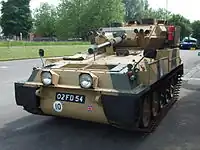 Scorpion at Aldershot military museum
Scorpion at Aldershot military museum
See also
- Combat Vehicle Reconnaissance (Tracked)
- FV102 Striker anti-tank guided weapon carrier
- FV103 Spartan armoured personnel carrier
- FV104 Samaritan armoured ambulance
- FV105 Sultan command post vehicle
- FV106 Samson armoured recovery vehicle
- Alvis Stormer – a larger development of the CVR(T) used in the case of the British Army to carry the Starstreak High Velocity Missile system and Shielder minelaying system
- Tosan, Iranian-built development of Scorpions supplied to Iran in the 1970s, carrying a 90mm gun and Toophan ATGM
References
Citations
- Razoux (2015).
- Staff Writer, "Alvis FV101 Scorpion: Light Armored Reconnaissance Vehicle (1973)", Military Factory, retrieved 10 October 2021
- "Scorpion". Jane's Information Group. Archived from the original on 21 February 2008. Retrieved 11 January 2009.
- "MV Spotlight: The Scorpion CVR(T)".
- "FV101 Scorpion: Keeping the Light Tank Relevant". HistoryNet. 25 February 2015. Retrieved 17 March 2018.
- "Fastest tank". Guinnessworldrecords.com. 26 March 2002. Retrieved 31 May 2014.
- Foss & Sarson (1995), p. 9.
- Foss & Sarson (1995), p. 10.
- Foss & Sarson (1995), p. 4.
- Foss & Sarson, p. 14
- "Tank Chats #109 Scorpion & TV15000". The Tank Museum. Retrieved 19 February 2021 – via YouTube.
- Chant, Christopher (January 1987). A Compendium of Armaments and Military Hardware. ISBN 9780710207203. Retrieved 31 May 2014.
- Foss & Sarson (1995), p. 12.
- Application Gallery: Steyr-Motors.com
- Thailand Army Weapon Systems Handbook.
- "Alvis FV107 Scimitar". militaryfactory.com. Military Factory.
- Bocquelet, David. "FV101 Scorpion". tanks-encyclopedia.com. Tank Encyclopedia.
- "FV 101 CVR(T) Scorpion". fas.org. Federation of American Scientists.
- "Scorpion CVRT FV101 Light tracked armoured reconnaissance vehicle". armyrecognition.com. Army Recognition.
- "FV101 Scorpion". military-today.com. Military Today.
- Cooke, Gary W. "FV101 Scorpion Combat Vehicle Reconnaissance (Tracked)". inetres.com. Inetres.
- Foss & Sarson (1995), p. 11.
- Hughes, Geraint (2011). The Military's Role in Counterterrorism: Examples and Implications for Liberal Democracies. US Army War College, Carlisle, PA: Strategic Studies Institute. p. 91. ISBN 978-1584874898. Archived from the original on 12 March 2017.
- Foss & Sarson (1995), p. 21.
- Foss & Sarson (1995), pp. 41–44.
- Foss & Sarson (1995), p. 37.
- Foss & Sarson (1995), p. 34.
- "50 years service for M113 - Australian Army". Archived from the original on 2 May 2016. Retrieved 20 February 2016.
- International Institute for Strategic Studies (2021). The Military Balance. p. 451. ISBN 9781032012278.
- Pietrzak, Wiesław B. (November–December 2002). "Alvis Scorpion". Wojskowy Przegląd Techniczny i Logistyczny (in Polish). Warszawa: Czasopisma Wojskowe. p. 40.
- "SIPRI arms transfer database". Stockholm International Peace Research Institute. 17 June 2011. Archived from the original on 14 April 2010. Retrieved 21 June 2011.
- Dominguez, Gabriel; Cranny-Evans, Samuel (26 January 2021). "Elbit Systems awarded contract for Sabrah light tanks and direct-fire support vehicles". www.janes.com. Retrieved 29 June 2021.
- "Philippines awards contract for light tanks and wheeled APCs to Elbit Systems of Israel". www.armyrecognition.com. 25 October 2020. Retrieved 29 June 2021.
- "China tank deal opens old wounds for wary". Bangkok Post.
- "Former Equipment of Iraqi Army". Archive.org. Retrieved 17 July 2018.
- Mark Nash (7 June 2018). "FV101 Scorpion in Irish Service". Tank Encyclopedia. Retrieved 3 April 2019.
- "Scorpions to be Retired - Malaysian Defence".
- Isby & Kamps 1985, pp. 303.
- Isby & Kamps 1985, pp. 285–7.
General and cited references
- Foss, Christopher F.; Sarson, Peter (1995). Scorpion Reconnaissance Vehicle 1972–94. Osprey Publishing. ISBN 1-85532-390-7.
- Isby, David C.; Kamps, Charles Jr. (1985). Armies of NATO's Central Front. Jane's Information Group. ISBN 0-7106-0341-X.
- Razoux, Pierre (2015). The Iran-Iraq War. Harvard University Press. ISBN 9780674088634.
External links
 Media related to FV101 Scorpion at Wikimedia Commons
Media related to FV101 Scorpion at Wikimedia Commons